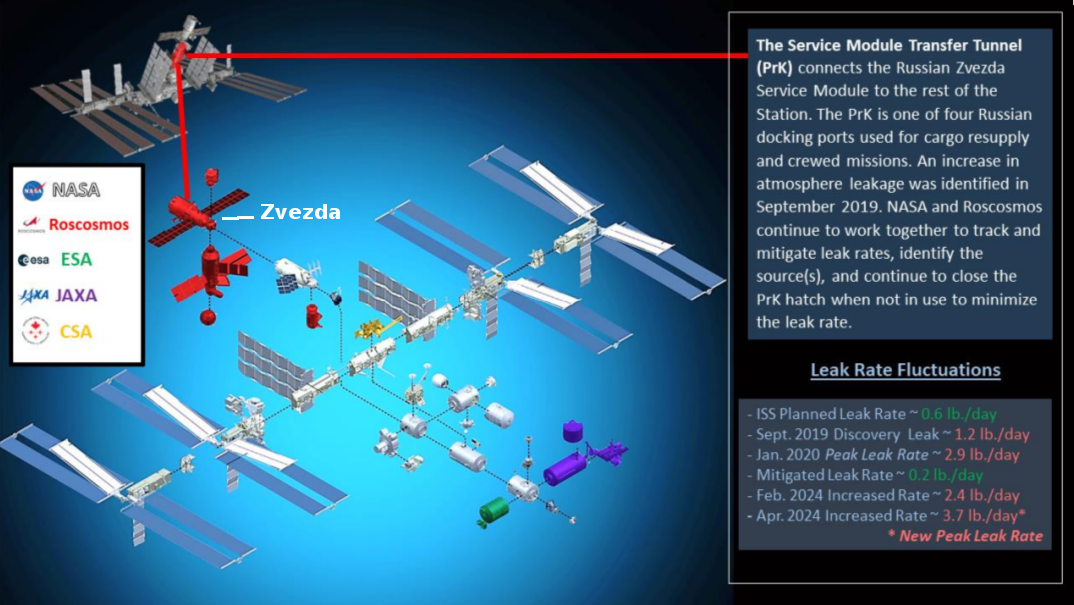NASA reveals that it and Russia disagree about the danger posed by the airleak on ISS

Figure 3 from September Inspector General report, annotated by me to show Zvezda location.
In a public session yesterday by a NASA commission focused on accessing the safety condition of ISS, officials revealed that the commission and Russia disagree about the root causes behind the airleak and cracks in the docking section of the Zvezda module on the Russian half of ISS, as well as the risk of a catastrophic failure. According to the commission’s head, former astronaut Bob Cabana.
The Russian position is that the most probable cause of the PrK cracks is high cyclic fatigue caused by micro vibrations. NASA believes the PrK cracks are likely multi-causal including pressure and mechanical stress, residual stress, material properties and environmental exposures.
The Russians believe that continued operations are safe, but they can’t prove that to our satisfaction. The U.S. believes that it’s not safe, but we can’t prove that to Russian satisfaction that that’s the case. So while the Russian team continues to search for and seal the leaks, it does not believe catastrophic disintegration of the PrK is realistic and NASA has expressed concerns about structural integrity of the PrK and the possibility of a catastrophic failure.
Because of this disagreement American astronauts now close the hatch between the Russian and American halves of ISS whenever a docking to Zvezda is taking place, and apparently keep that hatch closed until unloading of the docked spacecraft is complete. The Russians in turn only open the hatch to the docking section of Zvezda when they need to load or unload material into the freighter docked there, and coordinate with American astronauts whenever they do so.
Engineers from the two nations continue to discuss the issue, and hope to result their disagreement and come up with a joint plan.
Ultimately, this issue indicates the certain end of ISS in the near future, and adds ugency to the need to get some of those commercial space stations operating in orbit.

Figure 3 from September Inspector General report, annotated by me to show Zvezda location.
In a public session yesterday by a NASA commission focused on accessing the safety condition of ISS, officials revealed that the commission and Russia disagree about the root causes behind the airleak and cracks in the docking section of the Zvezda module on the Russian half of ISS, as well as the risk of a catastrophic failure. According to the commission’s head, former astronaut Bob Cabana.
The Russian position is that the most probable cause of the PrK cracks is high cyclic fatigue caused by micro vibrations. NASA believes the PrK cracks are likely multi-causal including pressure and mechanical stress, residual stress, material properties and environmental exposures.
The Russians believe that continued operations are safe, but they can’t prove that to our satisfaction. The U.S. believes that it’s not safe, but we can’t prove that to Russian satisfaction that that’s the case. So while the Russian team continues to search for and seal the leaks, it does not believe catastrophic disintegration of the PrK is realistic and NASA has expressed concerns about structural integrity of the PrK and the possibility of a catastrophic failure.
Because of this disagreement American astronauts now close the hatch between the Russian and American halves of ISS whenever a docking to Zvezda is taking place, and apparently keep that hatch closed until unloading of the docked spacecraft is complete. The Russians in turn only open the hatch to the docking section of Zvezda when they need to load or unload material into the freighter docked there, and coordinate with American astronauts whenever they do so.
Engineers from the two nations continue to discuss the issue, and hope to result their disagreement and come up with a joint plan.
Ultimately, this issue indicates the certain end of ISS in the near future, and adds ugency to the need to get some of those commercial space stations operating in orbit.
